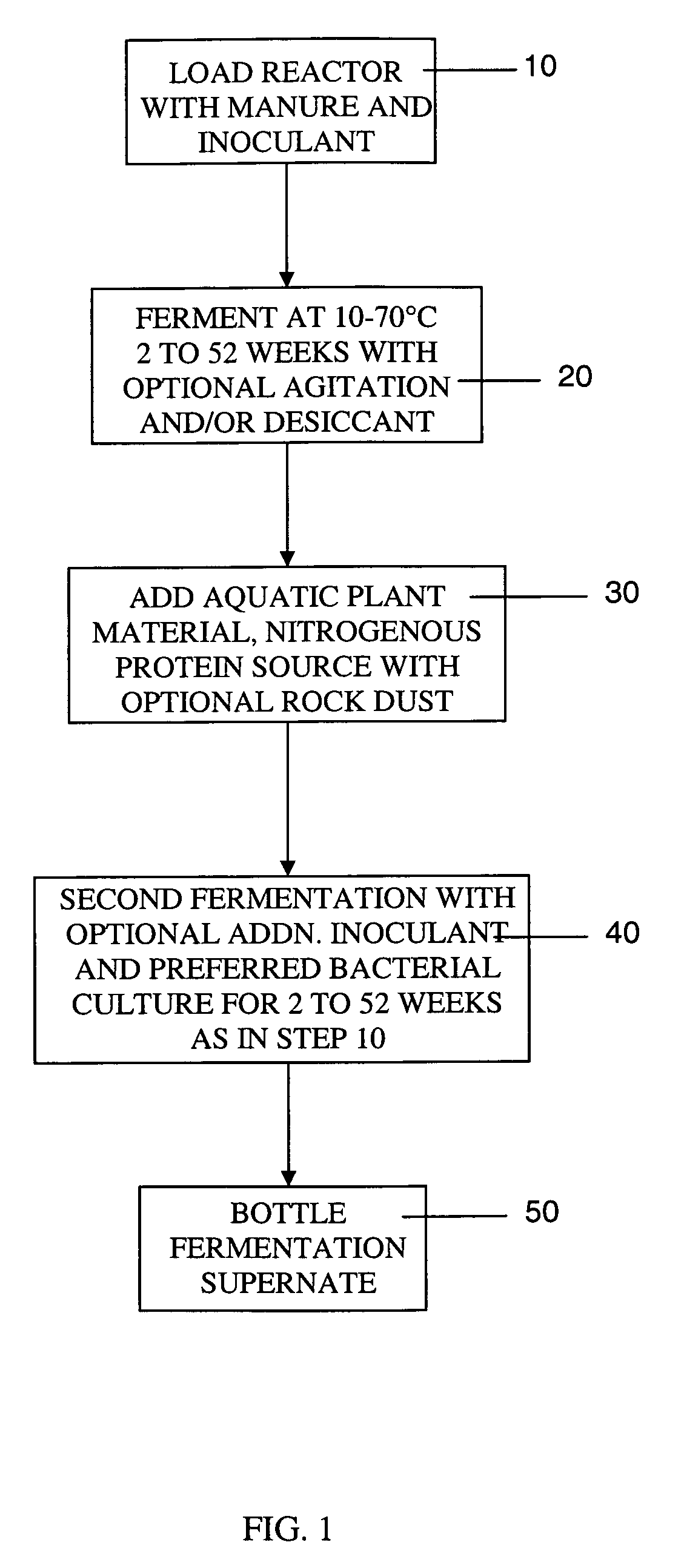Soil conditioner
a technology of soil conditioner and soil conditioner, which is applied in the field of soil conditioner production, can solve the problems of affecting slow breakdown, and ineffective fertilizers of manure and other waste products in the modern world, and achieves the effect of stimulating the growth and activity of earthworms
- Summary
- Abstract
- Description
- Claims
- Application Information
AI Technical Summary
Benefits of technology
Problems solved by technology
Method used
Image
Examples
example 1
[0016] 750 kilograms of organic cow manure is mixed within a vat type batch reactor equipped with a mechanical tumbler. A plant inoculant is introduced that includes 30 grams of yarrow blossoms, 30 grams of chamomile blossoms, 30 grams of stinging nettle whole plant in full bloom, 30 grams of oak bark, 30 grams of dandelion flowers, and 30 grams of valerian flowers. The resulting mixture is stirred at 15 revolutions per minute on average to maintain homogeneity of the mixture. The mixture is allowed to compost for 2 months at 28 degrees Celsius.
[0017] After 2 months 2,400 kilograms of certified organic fish emulsion, 240 kilograms kelp and 5 kilograms of rock dust is added to the now fermented mixture. 150 liters of plant based diazotroph bacterial culture is then added in addition to 30 grams yarrow blossoms, 30 grams chamomile blossoms, 30 grams stinging nettle whole plant in full bloom, 30 grams oak bark, 30 grams dandelion flowers, and 30 grams valerian flowers. 11,600 liters o...
example 2
[0018] The process of Example 1 was repeated with the addition of 1,000 grams of Dunalea Selena algae in concert with the bacterial culture. The resulting supernate after fermentation had similar nitrogen, phosphorus and potassium to the supernate of Example 1 as well as 500,000 milligrams per liter beta carotene.
example 3
[0019] A comparison of the ability of an inventive soil conditioner to simulate plant growth was undertaken relative to comparative product, Jungle Juice™ (AGM Foods, Queensland, Australia). Three tomato plants are grown in identically prepared plots with each plant being at the center of a 1 meter square grid square. Each of the compositions is applied according to use instructions with the inventive composition of Example 1 being applied in a quantity equal to that of Jungle Juice™. The compositions are applied 2 weeks after germination in a single dosage. Twelve weeks later, the plants are harvested and weighed. The plant mass is then normalized. The results are summarized in Table 2.
TABLE 2NitrogenPhosphorusPotassiumNormalized% wt / volmg / Lmg / LPlant MassExample 10.2622074181.0Jungle Juice0.0628449670.52
PUM
 Login to View More
Login to View More Abstract
Description
Claims
Application Information
 Login to View More
Login to View More - R&D
- Intellectual Property
- Life Sciences
- Materials
- Tech Scout
- Unparalleled Data Quality
- Higher Quality Content
- 60% Fewer Hallucinations
Browse by: Latest US Patents, China's latest patents, Technical Efficacy Thesaurus, Application Domain, Technology Topic, Popular Technical Reports.
© 2025 PatSnap. All rights reserved.Legal|Privacy policy|Modern Slavery Act Transparency Statement|Sitemap|About US| Contact US: help@patsnap.com

